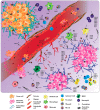Chemokines and Chemokine Receptors: Orchestrating Tumor Metastasization
- PMID: 30591657
- PMCID: PMC6337330
- DOI: 10.3390/ijms20010096
Chemokines and Chemokine Receptors: Orchestrating Tumor Metastasization
Erratum in
-
Correction: Marcuzzi, E., et al. Chemokines and Chemokine Receptors: Orchestrating Tumor Metastasization. Int. J. Mol. Sci. 2019, 20, 96.Int J Mol Sci. 2019 May 29;20(11):2651. doi: 10.3390/ijms20112651. Int J Mol Sci. 2019. PMID: 31146450 Free PMC article.
Abstract
Metastasis still represents the primary cause of cancer morbidity and mortality worldwide. Chemokine signalling contributes to the overall process of cancer growth and metastasis, and their expression in both primary tumors and metastatic lesions correlate with prognosis. Chemokines promote tumor metastasization by directly supporting cancer cell survival and invasion, angiogenesis, and by indirectly shaping the pre-metastatic niches and antitumor immunity. Here, we will focus on the relevant chemokine/chemokine receptor axes that have been described to drive the metastatic process. We elaborate on their role in the regulation of tumor angiogenesis and immune cell recruitment at both the primary tumor lesions and the pre-metastatic foci. Furthermore, we also discuss the advantages and limits of current pharmacological strategies developed to target chemokine networks for cancer therapy.
Keywords: angiogenesis; cancer; chemokine; metastasis; tumor immunity.
Conflict of interest statement
The authors declare no conflict of interest.
Figures

Similar articles
-
Role of chemokines in tumor growth.Cancer Lett. 2007 Oct 28;256(2):137-65. doi: 10.1016/j.canlet.2007.05.013. Epub 2007 Jul 12. Cancer Lett. 2007. PMID: 17629396 Free PMC article. Review.
-
The role of chemokines and their receptors in angiogenesis.Cell Mol Life Sci. 2011 Sep;68(17):2811-30. doi: 10.1007/s00018-011-0677-7. Epub 2011 Apr 9. Cell Mol Life Sci. 2011. PMID: 21479594 Free PMC article. Review.
-
Beyond Cell Motility: The Expanding Roles of Chemokines and Their Receptors in Malignancy.Front Immunol. 2020 Jun 4;11:952. doi: 10.3389/fimmu.2020.00952. eCollection 2020. Front Immunol. 2020. PMID: 32582148 Free PMC article. Review.
-
Chemokines in tumor-associated angiogenesis.Biol Chem. 2009 Dec;390(12):1213-23. doi: 10.1515/BC.2009.144. Biol Chem. 2009. PMID: 19804363 Review.
-
Angiogenic and antiangiogenic chemokines.Chem Immunol Allergy. 2014;99:89-104. doi: 10.1159/000353317. Epub 2013 Oct 17. Chem Immunol Allergy. 2014. PMID: 24217604 Review.
Cited by
-
Identification of key candidate genes and pathways associated with colorectal aberrant crypt foci-to-adenoma-to-carcinoma progression.Gastroenterol Hepatol Bed Bench. 2021 Fall;14(Suppl1):S41-S50. Gastroenterol Hepatol Bed Bench. 2021. PMID: 35154601 Free PMC article.
-
Identify potential prognostic indicators and tumor-infiltrating immune cells in pancreatic adenocarcinoma.Biosci Rep. 2022 Feb 25;42(2):BSR20212523. doi: 10.1042/BSR20212523. Biosci Rep. 2022. PMID: 35083488 Free PMC article. Review.
-
Identification of a novel MSI-related ceRNA network for predicting the prognosis and immunotherapy response of gastric cancer.Aging (Albany NY). 2023 Jun 12;15(11):5164-5189. doi: 10.18632/aging.204794. Epub 2023 Jun 12. Aging (Albany NY). 2023. PMID: 37310469 Free PMC article.
-
New perspectives on chemokines in hepatocellular carcinoma therapy: a critical pathway for natural products regulation of the tumor microenvironment.Front Immunol. 2024 Aug 14;15:1456405. doi: 10.3389/fimmu.2024.1456405. eCollection 2024. Front Immunol. 2024. PMID: 39206194 Free PMC article. Review.
-
Enhancement of innate and adaptive anti-tumor immunity by serum obtained from vascular photodynamic therapy-cured BALB/c mouse.Cancer Immunol Immunother. 2021 Nov;70(11):3217-3233. doi: 10.1007/s00262-021-02917-4. Epub 2021 Apr 5. Cancer Immunol Immunother. 2021. PMID: 33821298 Free PMC article.
References
Publication types
MeSH terms
Substances
LinkOut - more resources
Full Text Sources

